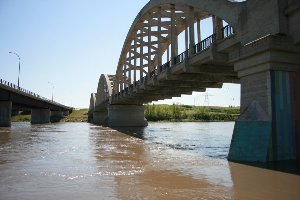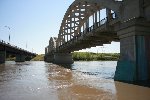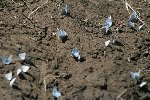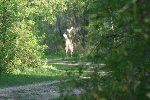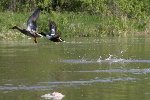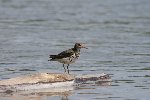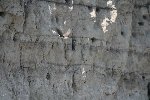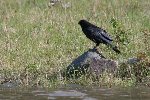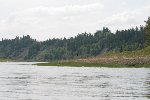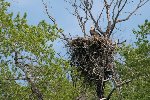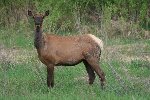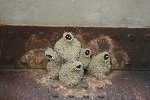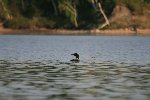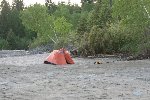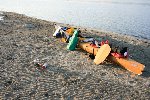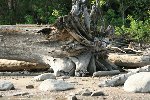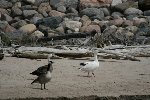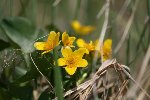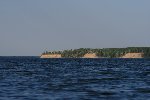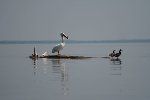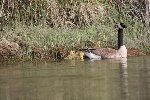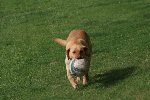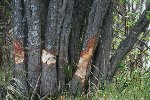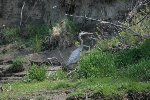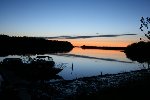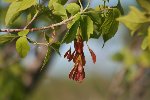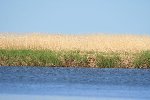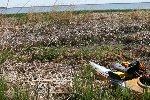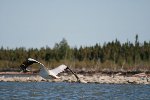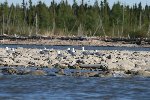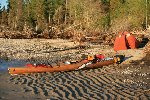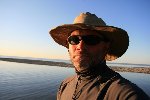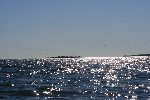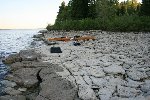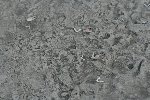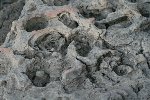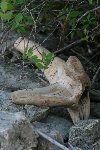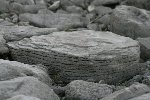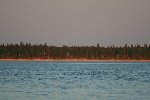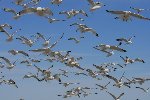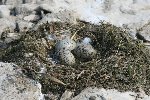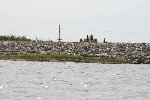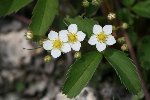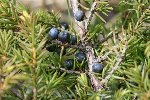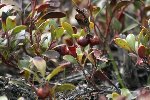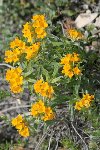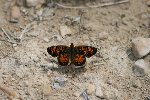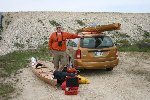Trail Description:
Borden to Grand Rapids: A River Travellerís ChallengeWhen I began this long journey on June 01, 2002, I did not expect to have the experiences that I encountered. My intension was to enjoy the benefits of the Saskatchewan Watershed quietly pushing myself through deep introspection and absent-minded doddling while enjoying my photography hobby. I wanted to write about a living river that I expected to be teeming with life in all of its natural forms. I found and experienced more than I thought that river had to offer. Within ten minutes of the start of my 2002 attempt at this journey and only a few kilometres along the way, the river almost took my life after I plunged into a class 6 rapid located within a gorge. It broke my kayak and stripped my person of anything not securely attached. During 2003, I successfully completed the first leg of this journey, which began at the Saskatchewan Crossing in the Alberta Rockies and ended at North Battleford, Saskatchewan, and ran a distance of 1000-kms. My expectations for this journey were fulfilled. During this leg of the trip, I also experienced death, not my own, but that of some unknown victim of a heinous crime. That discovery resulted in the fulfillment of another lifelong desire: to ride in a helicopter: that ride lasted 5-hours. During my 2004 attempt at continuing my journey, which I planned to paddle from North Battleford to Grand Rapids, Manitoba, severe weather and major equipment failures drove me off the river. This leg of my trip lasted only 1Ĺ days after I stopped just under the Borden Bridge, near Borden Saskatchewan> I paddled just over 180-kms. I listened to my heart, felt the bad karma emitting from my surroundings and bailed. Better to live another day and try again at some later date. During 2005, I had hoped to carry on with my trip but my life went to hell in a hand basket. During the month of May, I was laid off from my job as a senior chemical technologist after 23 years of service. Soon afterward, my marriage fell apart and by November I was on my own living a life I least expected to experience. I lost everything, including my children. I was also struggling to start up a home renovation company with the knowledge that although I was a good renovator, I was not a good businessman. I soon learned while renovating that I had little time to build kayaks or to go out and enjoy paddling. I developed a chronic shoulder pain that worsened after a year of renovating. During February of 2007, I managed to land a job working in a different laboratory and gradually brought my renovation career to an end. Once I settled into the new job and my divorce was finalized, I started planning to get back on the water to continue my river trip. I set my put-in date for June 01, 2008. I allowed nothing and no one to deter me from getting back on the water. This leg of my river trip would take me approximately 860-kms from the Borden Bridge to Grand Rapids, Manitoba, where the waters of the Saskatchewan Watershed drop into the north end of Lake Winnipeg through the Grand Rapids Hydro Electric Dam. Successful completion of this leg of the journey would mean that the total distance that I paddled along the river from start to finish would be roughly 2000-kms. It would also signify the end of my journey along the Saskatchewan Watershed.
I had three major worries regarding this section of the river trip. The first one was Tobin Lake. I would be paddling along the length of it, which provides for a lot of fetch for wind speed to build uninterrupted. Wave and wind could make my life a living hell or keep me pinned to the shores until conditions improved. The second concern was the myriad channels found below the Campbell Dam at the northeast end of Tobin Lake. The river divides into almost two-dozen channels along its winding route toward the 54th parallel. If I choose the wrong channel, I could either end up in a bog far from my chosen course or I could add days of extra paddling while I follow two separate channels that reach higher above the 54th parallel than I was expecting to go. The third and last concern was Cedar Lake. It is a shallow lake with a huge fetch: 100-kms from north to south and 120-kms long from west to east, with little to slow the winds down. I learned prior to launching that 3-4 people drown on that lake each year, that storms can whip the lake into a frenzy in short order, and that the fens and bogs shift the access channels so that even the aboriginal fishermen who fish the lake can get lost for days. If anything went wrong after I passed the dam, I could easily disappear and never be found. Well, ok, someone would eventually find the VJ and maybe my bones, assuming wildlife didnít drag them off for a late night snack. For this reason, I carried my driverís license with me. I also knew that if I did disappear, the VJ Guardian Spirit, my Waters Dancing Lightning 17, would help to ID my remains or at least indicate where I went down.
My preparations for this journey were very thorough. I planned to end the trip after 11 days. I gave myself 19 days in case I became lost or injured. I carried enough provisions for 30 days and beefed up my wilderness first aid kit to include antiseptics, topical anaesthetics, sutures, a wide variety of bandages, Advil and Tylenol. I had clothing for either very hot weather or very cold weather. I brought no rifle but had a good supply of bear bangers, rescue flares and my last resort weapon of choice: a military fighting knife with an 8Ē long double-edged razor sharp knife. My mom and friend, Manju, would drop me off on June 01 at the Borden Bridge, and then meet me at Winnipeg, Manitoba, on June 18.
Despite my anxieties regarding this trip, I slept quite well the night before the launch. We had scouted the river the prior evening and found water levels to be high and fast: conditions looked good to go. I was worried that my lower back could be a problem. I managed just one training run prior to launch day because the VJ was in dry dock for much needed repairs to get her ready for the trip. During that 3-Ĺ hr practice run, I experienced excruciating lower back pain, which only my chiropractor, Joan, could remedy. My solution to this potential problem was to build a wedge from 4 layers of Ĺ-inch closed-cell foam, which would fit in the space behind my lower back and provide improved support. I also cut 6 layers of rectangular shaped ľ-inch foam to layer more support behind my back if needed. Joan did express her concerns that I was not fit enough to start such a long journey. She knows my body well and knew that I had lost muscle tone and had gained roughly 20-lbs over the previous year. I assured her that I knew my body well enough to know that if I started out slowly, it would strengthen quickly. In the end, I was right, but her assessment kept me honest with myself. Thank you for that, Joan.
On launch day, while I prepared the VJ to go, two locals chatted with mom, Manju and me. They were as excited about the trip as I was, as were everyone else I met along my way to Grand Rapids. After easing myself into the VJ, I shoved her from the shoreline and began my journey. The weather was perfect with a bright sunny sky, no clouds to speak of and gentle winds. The muddy water grabbed the VJ and thrust her rapidly along its course. I looked back to wave good-bye and then turned to give my attention to the fast arriving bend in the river. What would I find around it, I wondered to myselfÖsoon, I would know. I felt freedom for what it truly means: an experience of complete self-dependency, thought and wanderlust. For the next 11 days, no one would be the boss of me. I would live by my wits and my preparations would be my only judge. From this point on I expected no problems until I entered the Cumberland Delta, what Bryan Sarauer called ďthe largest freshwater delta in the world and a major navigational challenge.Ē He also mentioned Codette Lake, which I had no idea about, especially the Francois-Finlay Hydro Dam that created it beside Nipawin, Saskatchewan, which I had to portage around unexpectedly: my map did not refer to the dam.
The first three days of river travel passed by uneventfully. I stopped occasionally to chat with local folks along the riverbanks who were out to enjoy the fine weather that I had been experiencing. I photographed the river valley every 4-kms and zoomed my 70-300mm lens on any wildlife I spotted. Clear blue skies and the songs of songbirds were my constant companions. I camped on sand bars and always chose to paddle through the narrower channels of the river so that I could be closest to any wildlife I might encounter. My daily routine was to wake up with the sun, be on the water by no later than 0600h, paddle until one hour before sunset, then sleep like a log. After day 1, I had paddled 55-kms, a good start. After day 2, I had paddled 77-kms, looking even better but my shoulders were hurting badly because I was pushing them a little harder than I should have. After day 3, I had paddled 140-kms but that distance also included the last 30-kms of the North Saskatchewan River, which flows quite fast. I was getting stronger by the day, eating well, despite not having cooked anything hot to this point. I depended on pemmican, power bars, dried fruit bars, Gatorade and water filtered directly from the river for nourishment. There was, of course, my daily can of Guinness, my end-of-the-day reward for being out there in the wilds of northern Canada. Remember folks, it ainít just a dark draft: itís a meal in a can.
[pic15 l}During day 3, I encountered class 1-2 rapids as the North Saskatchewan River raced through a series of 90 degree turns on its way to meet the South Saskatchewan River at a place called The Forks. At the Forks, I anticipated churning waters and standing waves: I met only gentle boils and slowly rotating whirlpools that moved with the current. From there, the river gradually widened and remained gentle flowing. Eventually, I would learn that the river becomes more like a very long lake due to the Francois-Finlay Hydro Dam at Nipawin.
The North Saskatchewan and Saskatchewan Rivers are tamed rivers, dammed at enough locations to generate electricity and minimize the risk of flooding. They still flood from time to time but nothing like they did during the time when my ggggggrandfather, John Peter Pruden. The following brief is borrowed from the Manitoba Historical Society on John Peter Pruden:
John Peter Pruden (1778-1868)
Fur trader.
John Peter Pruden was born at Edmonton, Middlesex, England about 1778. He had two wives, the first Nancy, a native woman by whom he had several sons and daughters, the second, Anne Armstrong, governess to a Mr. Macallum, whom he married on 4 December 1839 at Red River Settlement.
He entered the Hudsonís Bay Company service as an apprentice in 1791, and sailed in the Company vessel Sea Horse to York Factory, where he was stationed until 1795. From then until 1808 he served on the Saskatchewan River at various posts. He spent the winter of 1808-9 in Britain. He returned to take charge of Carlton House in 1809-10, where he remained for four years as inland master in the Saskatchewan River District. After the union of the Hudsonís Bay Company and the North West Company he was appointed Chief Trader. He was in charge of Norway House from 1825 until his retirement in 1837, having been promoted to the rank of Chief Factor in 1833.
After his retirement from the Hudsonís Bay Company he resided in the Red River Settlement. He was appointed to the Council of Assiniboia taking the oath of office and attending his first session on 3 July 1843. He was made a member of the Board of Works on 19 June 1844, subsequently being appointed chairman on 28 June 1847. In the Red River census of 1843 he is recorded as having considerable property, namely 25 acres.
Pruden died at Red River on 30 May 1868.
More information:
John Peter Pruden, Dictionary of Canadian Biography IX, 648-49.
John Peter would have got to Fort Edmonton through the only available route: the North Saskatchewan and Saskatchewan, and Hayes Rivers. He would have travelled in a York Boat, a design capable of carrying 5 tons of furs and supplies and propelled forward by hearty, powerful, hard-living, Metis voyageur oarsmen who spoke only the Metis language, michif. My journey has echoes of John Peterís journey.
The dam at Nipawin caused me no end of grief. When I arrived there, marker buoys warned me not to go any further toward the dam. I couldnít see past the dam so I didnít know where the river began again. I wasted time paddling back and forth across the river before I eventually determined that I would have to make a portage. I was swearing by now for the complete lack of information in-situ, to guide paddlers to a portage route. I chose to haul the kayak, fully loaded, up a slope to the west of the dam, then drag her along the side of a gravel road to where it looked like I might be able to find a decent put-in site. The portage distance was about 600 meters. I clipped my rescue rope, which had large biners tied to each end, to the bow hand toggle and dragged her to the new put-in. The hex-boron nitride (HBN) coating that I applied to the hull worked wonders for me. It caused the VJ to slide easily over the gravel. I didnít feel much of the weight of her roughly 150-lbs with all the gear in stowage. When I checked the hull later on, damage was minimal with only light scrapes and scratches.
I decided prior to starting the trip that I would use a voice recorder in lieu of a writing journal to keep a record of my thoughts during this trip. The voice files that I recorded during the Nipawin portage are a testament to my frustrations. I believe I may have invented a few new swear words. If you were to listen to this recording, you can hear my hard breathing, my swearing and my relief once the VJ was floating on water again. My reward for that struggle was an early can of Guinness.
From Nipawin to Tobin Lake, the river deepens and widens considerably. I was now in powerboat country so I had to keep my eyes open for drunken boaters and anyone else who might not see me on the water. I consider this stretch of river to be the umbilical cord of Tobin Lake. If you look at a map, that is exactly what it looks like and, of course, this stretch of river is where Tobin Lake gets its water. The Francois-Finlay Dam prevents silt from going any further north from here so the waters of Tobin Lake are clear and green. Fine weather still blessed me up to Tobin Lake. To shorten paddling distances along the shores of Tobin Lake, I had plotted several open water crossings that ran from point to point. During one of these crossings I encountered my first dose of nasty weather. Clouds had been building over my chosen route and I was heading straight under them. As I paddled under them they let loose a torrent of huge rain drops that hammered the surface of the lake. Amongst the large droplets of rain were pea-sized hailstones. The hail pelted me only for a short while but the rain fell for almost one hour. I came to label this weather system ďthe dragon on my backĒ. My dry top, spray skirt and wide-brimmed Filson hat kept me fairly dry. The dry top leaked a little water because its rubberized inner coating had started to peel away, a condition I did not discover until after the trip began. Still, I was warm and comfortable during the onslaught of water and ice so I kept paddling until the storm dissipated.
I paddled for three more hours before landing at the Wilderness Ministries Bible Camp on the north shore of the lake. There, I met Ron and Donalda, the wonderful couple, who spent the last 15 years of their lives building up the camp to the great site it is today. I was offered a hot shower, food, coffee and lots of chat. I listened to their stories and they heard mine: a fair exchange. We chatted until midnight, well past Ronís usual hour for bedtime. My campsite for that night was high and dry within the evergreen forest that engulfs the bible camp. That night I strolled to the beach with Guinness in hand to look at the stars and ponder the journey I had so far completed: I was happy to be me and to be where I was at that moment. I listened to a whippoorwill sing its night song during the evening. I was so pleased with Ron and Donaldaís generosity and love that I stayed for a few hours the next morning to help Ron erect a tarpaulin tent structure that he planned to use as a sheltered outdoor workshop.
The run from the bible camp to the Campbell Dam was idyllic. I made a major open water crossing of several miles through oily-smooth waters that reflected the partly cloudy skies to perfection. Warm humidity rose off the surface of the lake and streamed toward the skies. I breathed this moist air deeply with relaxed breaths. I kept an eye on the cloud formations and movements to ensure that I didnít get caught in a sudden storm. If the waves were to kick up suddenly while I was so exposed I could be in serious trouble. I eventually became fairly dozy as I made my way to the dam. I photographed anything that moved.
I encountered a major stroke of luck when I arrived at the Campbell Dam. Two Sask Power employees just happened by as I strolled up to the dam. I flagged them down and begged a ride to the put-in point. It was a few miles along a gravelled road in the area where the spillway reunited the waters of Tobin Lake with the river valley. I regaled the guys with my kayaking stories while we drove the fully loaded VJ to her new paddling destination. I thanked them for the help by offering them a few packages of pemmican. They were as thrilled as I was.
At the spillway, two kind folks, a man and a woman who must have been in their late 50ís met me. They were sitting on lawn chairs on the lush grasses near the spillway when they saw us drive down with the kayak loaded across the sidewalls of the pickup truck. When I turned to look at them walking toward me, I saw them, the spillway, the way the sun shone, the trees, the river, and the grasses around us: the whole scene was familiar to me. I had a very eerie feeling that I had been there before and met these two people before, except that I have never been this far north in Saskatchewan before. Later after I had completed the journey, I asked my mom if dad had ever taken me there. She replied that he fished at Tobin Lake once during a tournament but I had not come along. I recognized the area and have seen these two folks before. My memory did not fail meÖit was in a dream that I first experienced this place and met these people. I dreamed of this place long before I came here, exactly as I saw it now.
I spoke easily with the two folks as I prepped the VJ for the water. We spoke about my trip and my thoughts about being out there on my own. They thought it was an awesome experience and wished me well. I knew I would be fine. When it was time for me to launch, the man insisted that he wanted to help me move the VJ. I had to drag her over lush grass only a few feet before the ground fell toward the river. I really didnít need his help but I sensed that he wanted to touch the kayak in order to share in my experience. I let him grab the stern hand toggle rather redundantly and I eased the VJ down to the river. After I launched, I got out my camera and snapped off a parting image quite deliberately because of my eerie sense of deja-vous. I think, some day this image will help me figure out just what happened at the spillway.
As the VJ slipped downstream, I pondered my feelings about this experience and remembered the second part of the name of my kayak: Guardian Spirit. Strangely, with a clear mind and heart, I realized that those two interested folks could have been meant to be there at that point in time to ensure that I got through and left on my way safe and sound. I knew that with those two, if I had needed anything at all, they would have helped me without hesitation. This was a powerful feeling that came from within my soul. I am not a man inclined to mysterious thoughts and beliefs, but even as I write this I still believe what I have written. The feeling of being protected would stay with me for the remainder of my journey.
My greatest fear of this area was finding the river below the dam a mere trickle from its former glory. Certainly, below the dam that is exactly what it looks like. No water runs onto the riverbed below the dam and the river bottom is full of lush vegetation with puddles of water dotting the landscape. At the put-in point below the spillway, the river regains its glory. It is verdant and teeming with life. From here on, my next struggle would be to find my way amongst the many channels it melds into to get to Cumberland House, located at the south end of Cumberland Lake.
I would discover that the river from this point on is dotted with hunting lodges and trappers cabins used by the native hunters and fishermen. I stopped by one such lodge, primarily because of the large Metis flag waving atop a pole and also because the immaculate varnished log houses of the site were situated on a beautifully kept section of the riverbank. There, I met Nathan, an older Cree native with bad teeth, arthritic issues and a love of quiet, simple chat. The lodge comprised of a log house for a kitchen area, another log structure for sleeping quarters for the owners family, a sauna, and several outbuildings that served as bunk houses for paying clientele.
I followed Nathan around as he did a few chores then we retired to the kitchen to enjoy a cup of tea while we chatted. I noticed a bannock resting on the countertop. Nathan offered me as much as I wanted. Oddly enough, just two hours ago I was wishing that I could sink my teeth into some bannock. This trip of mine was beginning to seem filled with strange coincidences.
I learned from Nathan that a metis man named Solomon Carrier owned the lodge. Turns out that Solomon was once a world champion C-1 canoe racer. I would learn that Solomon is a active living legend amongst native communities in northern Saskatchewan and Manitoba. I saw a picture of Solomon racing a C-2 canoe with another man hanging on a wall and Wowie!, I have never seen musculature such as I saw in that picture. It was easy to see how he could have been a world champion in any sport he might have chosen to compete in.
I left Nathan resting on a chair perched on the porch of the kitchen cabin. Quietly, he asked me if I could be coming back to visit him. I hesitated then said I would find a way. Nathan indicated that there was a highway on the other side of the river from where the lodge is situated. I suggested that I could use the kayak to cross the river and drop in for a visit. That is one visit that I am sure I would enjoy very much. Nathan is a good man and we enjoyed meeting each other.
From here on, I depended heavily on frequent GPS checks correlated with checks on my aeronautical map. The river began to divide into its myriad channels. I knew that one wrong turn could lead to potential disaster. Local advice indicated that I should stick with the main channel at all times. I knew from my map that my shortest route, the so-called ďnew channelĒ was an offshoot from the apparent main channel. If I missed my turn then I would have two other main channels to pick from that flowed higher above the 54th parallel than I wanted to go. Those routes are very remote and would add extra days of paddling but they did both turn toward Cumberland House much further on. By the map, if I made any wrong turns on either of those channels, then I would find myself mired in bog way off course and lost till I could find my way out. Cell phones do not work up there and I am not sure if my ICOM could help me up there.
Shortly after leaving Nathan at the lodge, I had my first bear encounter. I was roughly 8 feet from the riverbank kind of idling my way along in a semi-dreamy state when I heard a sudden crashing sound in the forest to the right. I turned just in time to see the rump of a large black bear disappear into the bush. I was already yanking back the spray skirt to get at my camera when I spotted the bears rump so I knew that I had lost my shot at getting a photograph. As luck would have it, while I pondered my bad luck at missing a photo op with a bear, I spotted a mink romping along the top of the riverbank. I managed to get two photos of it before it too, disappeared into the thick brush.
Twice this day I made choices regarding channels that nagged at me. In both situations my gut feeling was to turn back and carry on along the channel that I had turned from. By obeying my instinctive senses I spared myself the risk of ending up nowhere fast. According to my map, those two channels ended in bogs. Because of the lack of finer details on my map and the fact that that those two channels occurred closer by other channels, I couldnít accurately pinpoint just exactly where I was. I had to paddle along for a time to judge my position properly. By the end of the day I had made the new channel and settled in for the night.
Once I reached the new channel, I would be making my run for Cumberland House. Cumberland House is the oldest permanent settlement in Saskatchewan and the crossroads on the fur trade highway through the interior being located on the Saskatchewan River at the junction with the Sturgeon-Weir River allowing access to the Churchill River, which in turn allowed access all the way to the Arctic Ocean (with a teeny little 19km portage). The Hudson Bay Company established it's first trading post inland from the Hudson Bay there in 1774. (Quoted from Bryanís commentary at Guillemot Kayaks, kayak forum, June 11, 2008). There, I hoped to stop by the village and buy a burger and fries. I had been craving them for some time and the idea that I was close caused my mouth and mind to drool constantly. Local fishermen informed me that I could get such a meal at two of the local stores.
The run to Cumberland House was nothing short of tough once I got close to the south end of Cumberland Lake. The gusting winds had picked up speed and were constantly driving me into the weeds. I struggled to take pictures but the kayak was swept toward my subjects, which then flew off to a new spot. Wave action increased as I struggled to further my cause. When I figured it was my time to head toward the delta where the waters of Cumberland Lake flow into the Saskatchewan River, I turned into the wind. I was seriously worried that I could capsize because the waves were getting larger, peaking at two feet with short periods and increasing in size the further north I moved. Many times they washed over the decks and filled the spray skirt with water. I spotted a fishing boat that turned into a sheltered area so I followed it in to get advice from the locals. They were surprised to see me out there and told me what I wanted to know. Stick to the south shore and then turn up a small river that moved with a slow current from Cumberland Lake to the Saskatchewan River. They warned me that if I stayed on the Saskatchewan River past the river from Cumberland Lake then I would encounter a major rapid, which they indicated was dangerous and unrunable. I followed their advice but came to an area where I was unsure where to turn. I opted to creep ahead along the Saskatchewan River until I heard that all too familiar roar of water tumbling heavily over a rapid. Memories of my nasty run over the rapids at the Rocky Mountains flooded back into my mind and I immediately tucked tail and headed back to the area I was unsure about earlier. The locals I met there indicated that this was the river I needed to take to Cumberland House. The river seemed to me to be more of a man-made channel because it was too uniform in width.
I endured a three-hour upstream paddle to finally get to the House. I immediately set up camp at the starting line for Cumberland Houseís canoe race site, the very site where Solomon Carrier got his beginning as a world Champion C-1 canoe racer. As soon as I was done setting up camp, I began walking toward the town center in search of my burger and fries. A car stopped almost as soon as I stepped on the road and a couple of women offered me a ride to the local restaurant, which was not more than one kilometer away. What a friendly town this was. I told her what I was doing there and she told me about the town. She offered to drive me back to camp after I was done my meal. I asked her how she would know I was done my meal. She laughed and said Cumberland House is a very small town indeed. At the restaurant, I met up with a man named Sid Carrier. Turns out that he was related to Solomon Carrier and even raced canoes for a time himself. Sid offered to help me move my camp from the south shore of the lake to the river, a 5-mile drive. He wanted to do it that evening because he didnít want to get up at 0500h to help me, my usual time for getting out of the sack. He suggested that after he had his meal, he would meet me at my camp and get me moved.
I ordered my burger and fries then used the washroom. When I got out my burger was on the table. I moved to sprinkle salt on the fries when suddenly the lid flew off. I stopped the flow of salt before any serious damage was done to my meal. I pulled the lid out of the gravy and held it upon my fingertip and called the server over. He cursed the kids who played that old game while I was chuckling out loud. That was the first time I had been caught by such an old ruse. Of course, I checked the peppershaker and sure enough, the lid was loose. I spoke with the server about my trip as I ate. He moved from China to Cumberland House with his family and parents to find a better life. The family operated the store cum restaurant. We enjoyed our mutual chat and soon it was time for me to head back to my camp.
I opted to walk back since the kind woman who offered to drive me back was not there yet. As I walked along the main road back to camp, I was warmly greeted by families out for pleasure walks. I watched children scramble around the town playing games and shouting out loud at each other just I had done when I was their age. I felt very much at home walking back to camp and thought that I would love to live in such a village if I could find a way to earn a living. Just before I reached my camp two young girls stopped to ask me about my kayak and trip. They asked me if I was ever scared at times. I replied that I was just a little scared at times but that I had confidence in what I was doing. I told them that because I was a big strong man I was able to figure out what to do when things got bad. They looked at me with large googly eyes while they smiled at my description of myself. Sid drove up and I raced over to the camp to load my stuff onto the back of his truck. For a second time, I found wonderful luck when a major portage was needed. I hoped my luck would continue.
I launched early in the morning before anyone at Cumberland House was awake. From there on, I was eager to reach Cedar Lake. The river here is very similar to the river in the Edmonton region less the deep valley found in Edmonton. In fact, the river rarely changed character once I was beyond Prince Albert, Saskatchewan. The one difference that I started to notice in the Cumberland Lake region was the increasing presence of bogs along the shores and beyond. Marsh birds became ever present. Terns became my constant companions. Tall yellow fenegue grasses, reaching heights of almost 8 feet lined the shore in some places. I knew I was getting close to Cedar Lake. I met and spoke with local fishermen often enough. While floating along we chatted about the river, Cedar Lake and my journey. I was warned once again about a man who attempted to cross Cedar Lake in a 12 foot fishing boat during 2007: he never made it. He was found drowned. Apparently, he attempted the crossing without a life jacket. I always kept mine handy on top of the deck, just in case, and used it any time I was unsure of conditions.
About three hours before I set up camp for the night, I met a group of hunters led by a Metis guide. They had just arrived at their campsite and were setting up tents and equipment. They hollered across the river and invited me to stop for a beer, an offer I could not turn down. They spotted me earlier working my way downstream and said that they were impressed with how far I had come. We introduced ourselves to each other, but I cannot remember their names and did not record them on my voice recorder. They demanded that I drink their beer and told me to put my can of Guinness down. I obeyed instantly. They peppered me with questions about the kayak and the journey. They couldnít fathom how I could survive in the wilderness for such a long time with such a skinny little boat. I explained where all my gear and provisions were stowed. Once done, they understood me well. After an hour of visiting I had to leave to carry on with the trip. I wanted to reach the entry to Cedar Lake by nightfall. They insisted that I take a spare can of beer with me for the road: I did not refuse the offer. They informed me that if I paddled far enough, there was a ranger station with three rangers staying the night there on the last big island before Cedar Lake. The guide was sure they would let me camp on the nice lawn if I made it that far. I made every effort to track down the station.
One hour before nightfall I found myself at what I thought was the ranger station. I spotted a young man standing on a dock smoking a cigarette. He spotted me and waited while I raced with powerful strokes across the river to meet up with him. I greeted him well and asked if he could offer up a patch of grass for me to camp on. He offered me better. A whole crew of students came out to see what the commotion was and invited me up to the kitchen tent. There were seven graduate students in all, doing a variety of studies at the Summerberry Marsh, a conservation project sponsored by Ducks Unlimited. They were pumped to have a visitor as interesting as I was because of my long river journey. Apparently they were kind of bored with each other so I was a refreshing break in the routine for them. We plied each other with stories of their research and my river adventures. One of the boys was lusting after a Guinness when I confessed to carrying a small stock with me. I went to the kayak and brought one for him. They all had a share. I also plied them pemmican since none of them had ever tasted it before but had heard of it. We chatted until almost midnight then the crowd started to thin. One student had to get up at 0400h and offered to wake me. I told him that was too early for me and that I had a nice internal clock that woke me up at 0500h each morning. That said, we all turned in for the night. I was offered a hot shower and a bunkhouse to use for the night. It wasnít mosquito proof so I set up my tent without the fly inside the house.
I arose early in the morning and was on the water by 0600h. The students were all still sleeping so I moved quietly while I prepped the VJ for my first day on Cedar Lake. I had about 20-kms to paddle before reaching the end of the Saskatchewan River, which actually entered the lake near the center of the western portion of the lake. My intention was to use the main channel to enter the lake, which is the branch that runs straight into the central part of the northwest section of the lake. Instead, I found that I had turned right when I should have stayed left so I entered the lake via the rightmost channel. That was a turn of events that would annoy me to no end.
When I left the river and entered the body of the lake, I was dismayed to discover that the lake was so shallow that the VJ bottomed out. I looked around and saw very choppy shallows that extended for hundreds of meters. The water was a beige/brown color because of all the silt that was being stirred up by the winds, which were growing in strength due to the uninterrupted fetch of that part of the lake. I broke my paddle into its two halves and used them to pole the kayak roughly 300-400 meters to deeper water. Once I reached deeper waters, I reconnected the paddle halves and began what would become a very tough slog to reach Poplar Point. I could see the point in the distance: it was far away but seemed to be near the main body of the rest of Cedar Lake. Wind and wave constantly turned the VJ in a northwest direction but I needed to run her in a southwest direction. In the end, I reached my destination but only after roughly 4-hours of shoulder-burning effort. When I reached the point, I exited the kayak to take a break and stretch my legs.
From the point I turned to what I thought was the most favorable spot to access the main body of the lake. I did another smaller open water crossing only to discover that the entire northwest corner of Cedar Lake was locked in by fen and bog. I remembered reading stories about how the local aboriginal fishermen sometimes got lost for two days because of shifting channels throughout the boggy sections of the lake. At this point, I was tired and wanted only to find a way out of this situation. I swore to the skies out loud and bitched to no one in particular about what a ridiculous lake this was. How the hell could I come so far only to find myself trapped in such a frustrating condition? All I saw from one end of this portion of the lake to the other was a long line of fenegue grasses growing on mud banks. I used my 300mm zoom lens to scout out a channel but I could see nothing at all that might serve as a way out. First I paddled one way, and then I changed my mind and moved in another direction. I searched for the hint of a possible escape route but found none. I could see the deeper blue water on the other side in the far distance but I could not find a way through the fen. I was almost in tears with frustration as I scoured the sides of this barrier to find a way through.
I had been heading west when I decided to change my direction again. I turned east and moved closer to the shore of this great annoyance. Within 5 minutes of making this decision my frustrations were eased by what looked like a channelÖa possible escape route. Originally, I saw it only as a tiny bay but because I was closer and looking at it from a different angle, I saw that it was actually a winding water-filled pathway that wandered toward the deeper waters on the other side. I moved the VJ along this route and sure enough, it was winding through the 200-meter bog toward the main body of the lake. I was not more than 20-meters from the open water when the channel became too shallow to paddle through. I shouted out new swear words that were swallowed by the wind for no one to hear except gods and geese who didnít care. Marsh birds seemed to flutter up with each battery of words I offered up. I broke my paddle and tried to pole my way closer toward the blue water but they immediately sank more than a foot into sucking mud. I knew then that I could not disembark and pull the VJ through. The mud was most likely deep enough to swallow my body into eternity and now it held the VJ with its sticky sucking grip. My heart was pounding after making such an effort to move forward. I drank deep gulps from my Gatorade bottle as I pondered my worsening situation. It was with deep regret that I started to shove the VJ back from where I came from. I had decided to paddle out of the shallow and possibly waste the rest of the day trying to find a way out. I knew from my aeronautical map that I probably wouldnít find a way out.
As I moved the VJ backward, hard-fought inch by hard-fought inch, the mud finally released its grip on the hull and she slipped easily back into the deeper waters of the channel. It was then that I spotted an opening along the shore that I saw earlier. There was a short length of mud there that I could park the VJ along in order to get out and stretch my legs and do some hard thinking. I got out and studied my surroundings. While I was doing that my feet were slowly sinking into the mud so I stepped onto a mat of dead duck weed. I noticed that my feet didnít sink. I was only about 75-meters from the open water at this point: I couldnít see that before from the kayak while she was afloat. I made the decision to portage her across the matted carpet of duckweed.
I clipped my rescue rope to the bow hand toggle and heaved her up onto the mud. The effort caused my feet to sink quickly so I knew that with quick steps, I could probably make it to the open water as long as my feet used the dead fall for support. Several times I had to step onto the areas with no deadfall and my legs sunk to the knees but I yanked them out as quickly as they sunk and kept moving forward. Momentum was the key here. In short order I was almost hip deep but at the edge of the open water. I maneuvered the VJ near some deadfall and stepped onto the mat while leaning on the VJ. With almost gymnastic maneuvers I got each foot into the cockpit then aggressively slipped my butt onto the seat while jamming my legs quickly into position. I was so happy at this point that now my tears were for joy.
From then on, I would be making long open water crossings until I got to my campsite for the night. I cared not one whit for the hard paddling I had to do during the crossing. I knew that I was very fortunate to be where I was now, paddling through clear bluish waters toward a good nights sleep. While I did the crossing, I opened my daily ration of Guinness and enjoyed that light-headed feeling of hard won freedom.
The next day after such a struggle I would carry on earning my mileage in a hard won manner. There were only gentle winds that tenth day of my journey, but because of the 100-km long fetch, the wave action was challenging. I tried to stick close to shore but one annoying characteristic of Cedar Lake is the amazingly shallow shoreline dotted with rocky points and outcroppings that can be encountered even 400-meters from shore. To paddle far enough from shore to avoid the rocks, you had to deal with the waves. Often I dealt with one-foot chop, which was no real problem, it just slowed my progress but I did not mind that. It was the sets of three two-foot waves with a wave period of six-feet or less that made life difficult. They hammered the VJ and caused me to strain my shoulders for hours on end. The bow would rise over the first wave then drop and crash into the bottom of the middle wave, then rise over the final wave.
On Cedar Lake, you either try to follow the shoreline and add days to your paddling adventure of you make open water crossings and deal with the waves. Since the shoreline has little to offer except monotonous, flood damaged shores that resulted from the Grand Rapids Dam, the open water crossings are more fun even if they are at time, difficult. I was not interested in pushing huge miles each day just to put miles behind me to set records for daily distance, I was pushing a little to make sure I met Ken at the put-out point so that we could paddle Black Island on Lake Winnipeg. Paddling Black Island is very a very beautiful experience that I wanted to relive.
My destination for today was Easterville, an aboriginal community populated by the Chemawawin First Nations. I was under the impression that I was a couple of hours from reaching the village: I was wrong. Three Chemawawin fishermen who stopped by to offer food and a tow (for some strange reason), explained that I had a 12-mile open water paddle to reach it. I looked to where they pointed and could just barely see the microwave tower at Easterville. After convincing them that I had plenty of food and did not want a tow, we parted ways with friendly waves. I gritted my teeth emotionlessly and pointed the bow of the VJ in the direction of the microwave tower.
That crossing took me 6-hours because of wind and wave action. I encountered only one short period of time when the waves eased up just a little. I was often amazed that there were any waves at all with such a gentle wind. At one point I swore out loud because with almost no wind, there just shouldnít be any wavcs but they were hammering me as usual. I was getting tired of being spun parallel to the waves.
Once I had the jetty at Easterville in my sights, I used longer more powerful paddling strokes to end my marathon crossing. The closer I got to the jetty, the harder the wind blew. I was not more than 400-meters from its shelter but only inching my way forward with powerful strokes because the winds were increasing in force so much. I had to cinch up my hat string to ensure that the wind didnít steal it from me. I valuve that hat as much as a video addict values his/her favorite game. When I finally found safe haven behind the jetty the VJ simply shot toward the edge of the shoreline as if she was shot out of a sling shot. I pulled her out of the water and sat down on a large rock to rest my tired body.
Once I was rested, I walked over to a pickup truck where several locals were chatting. They had been watching me and wondered who I was. I introduced myself and asked where I could get a burger and fries. I learned that the buger joint didnít open until 5 pm, so I was out of luck. I walked over to the reserve office and used a washroom. There, I spoke with a few locals before heading back to the VJ. I stopped by the local grocery store and bought a pathetic excuse for a submarine sandwich, which was more bun than sandwich and contained a few awful fatty slices of salami or something. Still, it tasted good so I gobbled it up, knowing that I would suffer heartburn later on. I suffered through the heartburn for two hours afterward but I drank water and toughed it out. I paddled on until I reached waters sheltered by a high rocky and relaxed into rhythmic easy strokes until I found my last campsite for this journey.
My final campsite was situated on top of a large flat of limestone that faced Grand Rapids. I could see the microwave tower for the town but that was not my final destination. I wanted to land on one of the many dikes that line the shores just before the Grand Rapids dam. I chose that spot because from my map, it looked like the best place to land. I could care less that I stopped just a couple of kilometers from Grand Rapids because as far as I was concerned, I will have arrived at the end of my journey along the Saskatchewan Watershed. I explored the campsite and photgraphed whatever looked interesting. After I finished a celebratory can of Guinness, I hit the rocks and slept a dreamless sleep.
The next day I expected, or hoped, that I would be able to paddle through glassy flat waters to the put-out point. I used my ICOM VHF radio for the first time ever and learned that the weather report was favorable for the Grand Rapids area. The first hour was picture perfect. I was on the water by 0500h and was totally relaxed: that feeling would be short-lived. Cedar Lake is a restless lake and after the first hour of paddling, I was back to shoulder wrenching strokes to keep the bow aimed at my final destination.
Two hours later, I came to a rocky island populated with thousands of gulls. I landed and stepped out to answer the call of nature. That done, I walked carefully along the shore and discovered that the island was one large nesting area for the gulls. I photographed a few of the nest sites while agitated birds flew around me as thick as a cloud of hungry mosquitos. Once I was satisfied with my photography, I launched the VJ to give the birds back their peace. From there I would make a final open water crossing to reach the dike of my dreams.
Even close to the dikes, the lake would not let me rest. It tried to drive me into the limestone shores but I continued to refuse it with passion. As I turned into the cove near my landing point the waves eased and disappeared: I was home free. My spirit relaxed as I paddled along the cove to choose my exit from this lake that I learned to hate. It gave me no rest and tried to drown me with its waves.
Once I selected my exit point, I moved the VJ carefully into a small slot where I could safely exit her. I used my rescue rope to drag her fully loaded to the top of the dike, scraping her new coats of varnish but not caring one whit. I was off the water and my sea legs knew it. They wobbled and left me unbalanced as I worked the VJ up the steep side of the dike. Once she was atop the dike, I opened a can of Guinness and relaxed while I waited for Ken to find me. I waited for 4-hours and thoroughly enjoyed myself by indulging in photographing local flora. I did spot a bear track but couldnít tell how fresh it was because it had been raining recently. I decided to load up a bear banger just in case and strapped on my big knife. Once done, I enjoyed a long walk along the dike and breathed the hot air of the early afternoon. It was hot out. I was tempted to go jump in the lake but I was too tired of the lake to care much more about being wet again.
When Ken found me I was sitting in the back of a pickup truck driven by two workers I managed to flag down. I had begged a ride to the highway that I knew Ken would use to find me. I figured on shortening his search for me in that wild part of Manitoba. As luck would have it, Ken was on top of the dike nearby. I spotted him and the drivers not only stopped to let me off but unloaded all my stuff beside Kenís car. Kenís grin was huge when he spotted me. Once the workers had left, Ken opened a couple of bottles of locally made stout, which we enjoyed while we relaxed. Ken also offered me the requested double-double from Timís. Ahh, so nice to be back on dry land!
Of the places I paddled through during this journey, I would highly recommend that section of river with all the channels below the Campbell Dam at Tobin Lake. It is absolutely beautiful down there. The different channels offer some excellent close-to-shore paddling with plenty of opportunities for photgraphing wildlife or just watching it as you pass by. With an aeronautical map and GPS, you should be able to find your way to Cumberland House, where you can stay and do some seriously good fishing or just hang about and meet the friendly locals. There are fishing guides all over the place so you can fish from your kayak or fish from their larger boats. Birders will have fun identifying the myriad marsh birds and other land-based birds. Eagles are plenty to be seen as are hawks, owls and other birds of prey.
The east end of Cedar Lake is also a wonderful place to be but only if the winds arenít churing out those damned wave sets. There are islands to explore and plenty of locals to help you when asked. I am sure that the northern shores of Cedar Lake would be a good place to kayak as well since the fetch would be next to nill over there. My bet is that a good week out, week in journey along the north shore would be rewarding.
I had only two failures during this journey. The first was losing my strobe light when I put my life jacket on in preparation for running a few class 2 rapids along the last few kilometers of the North Saskatchewan River. I was depending on it in case of emergency during my open water crossings. The strobe was to signal to possible rescuers where I was in case I was disabled and still on the open water at night. I had 6 hand fired rescue flares on standby so I was not too worried at the loss. The second failure was with my Swiss Gear self-inflating bedroll that I bought for the trip. It blew a seam on the fifth day and could not be repaired. I still slept comfortably for the rest of the trip.
I hope you enjoyed reading this trip report as much as I enjoyed doing the trip.
Robert N Pruden
June 27, 2008
